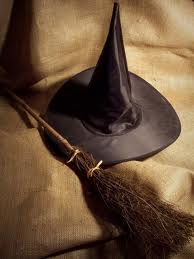 Is your broom handy? The witch’s broom has become an iconic symbol for the witch, and through the years, has taken on many different uses and associations.
Is your broom handy? The witch’s broom has become an iconic symbol for the witch, and through the years, has taken on many different uses and associations.
History
In the early days, the broom was used as a cleaning tool and a sybmol. If a woman left her broom propped up outside the front door, neighbors knew she was not at home. Brooms were also hung just inside the door with the bristles up to ward off evil spirits. Even today, witches use brooms to ward off negative energies or people by placing the broom above the door. Brooms are used for purification in many spells.
Early brooms were known as a besom and consisted of twigs tied to a handle. The Shakers created the flat broom in the 1800s. [1] In 1839, the United States boasted 303 broom factories. [2] (Either a great deal of cleaning was needed, or the witch population was booming.)
Brooms and Flying
In the past, it was commonly believed that witches flew on their brooms to sabbat meetings, which were frequently held in the woods. Some research of folklore claims that witches flew on the brooms with the bristles facing downward to erase their passage. Others believe the witches flew with the bristles parallel to the ground and placed lighted candles on the bristles to light their way.
While the witch’s broom is almost always associated with females, it was a man, Guillaume Edelin, who first confessed to riding his broom. [3]
Today, brooms are commonly composed of synthetic bristles. But the image of the witch’s broom remains a besom. Often, these brooms are decorated with flowers and fauna which are in season.
Cultural Uses
 The witch’s broom is most often celebrated during the Halloween season, and it’s popularity continues to grow. There are coloring pages for children and cookie recipes to make broomsticks. And of course, brooms are still used in cleaning.
The witch’s broom is most often celebrated during the Halloween season, and it’s popularity continues to grow. There are coloring pages for children and cookie recipes to make broomsticks. And of course, brooms are still used in cleaning.
So, where do you leave your broom when you aren’t using it? It might be a good idea to hang it over the door this October.
[1] Broom.
[2] Fugate, Tally D. Encyclopedia of Oklahoma History & Culture. “Broom Factories.
[3] Cavendish, Richard, ed. Man, Myth and Magic: An Illustrated Encyclopedia of the Supernatural. 1970.